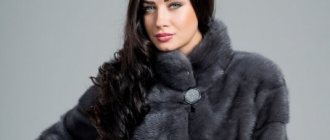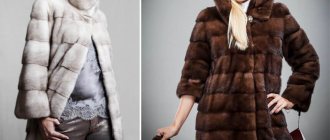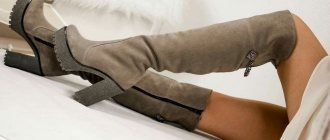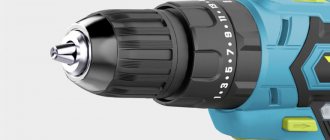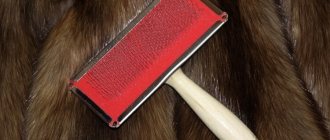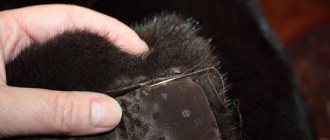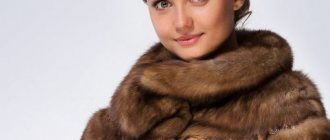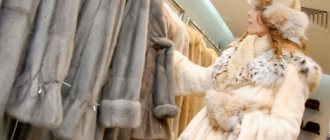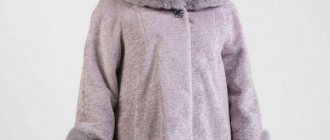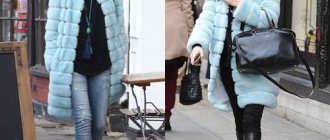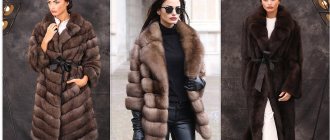A mink coat is a necessary wardrobe item for every modern woman. It is the fur of this animal that is considered one of the most expensive, beautiful and elegant, and products made from it are a sign of good taste and prosperity. To buy a truly high-quality mink coat, you need to be able to distinguish real mink fur from a fake; to do this, pay attention to several important points.
How to distinguish a good mink coat from a fake
When choosing the desired new thing, first of all, you need to know how to distinguish a real mink coat from a fake. To determine the authenticity of the fur, you need to run your hand over its surface - natural mink is very elastic, soft and does not have prickly fibers. Such fur immediately returns to its original state, and its undercoat has an even and fairly dense structure.
How to distinguish mink from the fur of a marmot, honorik or rabbit?
Very often, cheaper fur, for example, marmot or rabbit fur, is passed off as real mink. How to distinguish a mink coat from a rabbit , you ask. Yes, very simple. Rabbit fur that is stroked against the direction of the fur does not return to its original position, and its guard hair has an uneven surface.
to distinguish a mink coat from a marmot . It is enough just to carefully examine and feel the fur. In a marmot it will be much softer, and the frame will be uneven. Very often, unscrupulous manufacturers trim the frame to make it as similar as possible to natural mink, but this trick is also easy to expose. The sheared frame, even with a very careful and professional haircut, remains prickly and rough.
Recently, another type of fur has appeared on the world market - honorik. This artificially bred animal has some similar features to mink, but still, its fur is much cheaper and looks simpler than natural mink. In order not to fall for this trick, you need to know how to distinguish a mink coat from an honor coat . The most important criteria for distinguishing the two types of fur are:
- color of fur and guard hair;
- down structure;
- pile length;
- size of fur plates;
- product price.
In Honorik, the guard hair is colored dark, and the underfur is lighter, while the fur of natural mink is colored in the same tone and has no transitions. Mink fur is dense and dense, while that of Honorik is much less dense. The pile of Honorika fur is longer than mink, but the size of the mink’s fur plates is significantly smaller than that of its artificial double. The price of the product itself is also of great importance.
Remember: a high-quality natural mink coat cannot be cheap.
Don't be fooled: how to distinguish a Chinese mink from a Russian one?
Friends, we are often asked the question “Why do you have such an expensive mink?” and compare the prices of other sites and retail stores, where mink coats cost from 30,000 to 80,000 rubles.
Yes, we agree that the prices are very tempting. But what do you get for this money? Let's take a plunge into the past and remember that a mink coat used to be a symbol of financial well-being and high status in society. And it cost a lot of money. Today the situation has not changed, and high-quality Russian mink is still not cheap.
Unfortunately, the situation with counterfeits has worsened in the country. It can be said that the scale of consumer deception has become frightening. And here I would like to stop in a little more detail and tell you the essence of what is happening. In August 2021, Russia passed a law prohibiting the sale of fur coats without KIZs (electronic chips on which all information about the fur coat itself and its manufacturer is stored). A fur coat produced in Russia must have a green KIZ, while an imported fur coat must have a red one. To legally receive and hang up a red KIZ, you need to officially declare the imported goods at customs and pay duties. This significantly increases the cost of imported fur coats, and makes working with this product not very profitable.
But a way to get around this barrier was found. We live in Russia! Some unscrupulous domestic manufacturers, taking advantage of their status and the opportunity to use green CIZs, began to “legalize” imported goods. Chinese fur coats, as before, are imported past customs, the lining is altered in factories and workshops, and the original Chinese tag is replaced with a domestic one. And all this gray counterfeit, under the guise of a domestically produced product, is spreading throughout the country’s fur retail trade, including online trade... Violating the law and circumventing the budget is not so bad. The most offensive thing is that customers are being blatantly deceived. All these fur coats are sold as “Russian mink” or “Scandinavian mink” (usually the first option). Unfortunately, this is difficult to prove. And we are not able to specifically point the finger at someone in the absence of documentary facts.
It is not always easy for a non-specialist to distinguish a good quality mink coat from a bad one. What measures should you take to avoid becoming a victim of deception? We suggest you ask the seller a few simple questions.
- First of all, ask if the mink is dyed. Russian mink is all natural and is not subject to any dyeing! (in rare cases, only skins with a higher level of defects are dyed) If the fur is dyed, then this product is 90% in no way connected with Russian production. Real Russian mink is raised in fur farms, and the natural colors bred are very beautiful, they are not dyed. Any Russian fur farm will confirm this to you, you can call and check.
- Russian mink coats are made from solid plates. Chinese fur coats are sewn mainly either using the “unraveling” technology, or by placing the skins transversely. If you ask the seller to show what is under the lining, and you find that the fur coat consists of longitudinal narrow strips of fur sewn together, this is 99% not Russian mink. Our mink is of very high quality; it is not cut or sewn using this technology.
- If a store (or online store) claims to have Russian mink coats, then ask the seller about the possibility of making minor adjustments to the model at the Russian factory with which the store cooperates. For example, sew such a fur coat 10 cm longer, or make a collar instead of a hood. If the seller starts telling you that this is impossible for any reason, or talking about long terms, then most likely this product is not made in Russia, and delivery from China is included in the long waiting period. If this is actually a product made in Russia from Russian mink, what factory would refuse to sew and sell a fur coat with modifications for the client? And the issue should be resolved within a month at most. We declare this responsibly as a manufacturer and are ready to do it, we have nothing to hide!
- Evaluate such a thing as the fit (the width of the fold of the fur inside the shelf) and the smell. Chinese fur coats, as a rule, have very economical fit and smell: 2 cm and 4-5 cm, respectively. Good quality Russian mink coats have a trim of at least 4 cm and a smell of 9-10 cm.
If we talk about a factory-made fur coat made from Russian mink, then it is very warm and tailored specifically for our sometimes harsh winters, it looks very noble, and with careful use it will delight its owner for many years. The fur of the Russian mink is fluffy, has a thick underfur, long guard hairs, and a dense inner core. Chinese mink is very thin, the hair is thinner and shorter, the skin tissue is very stretched. Because of this, Chinese mink coats are very light, but the temperature conditions are seriously affected (they do not warm well) and especially the quality and durability. Almost every week, by mistake (they confuse us with those who sold them), dissatisfied customers call our hotline with complaints about Chinese fur coats, either a sleeve has torn, or something has worn out after a week of wear... In addition to the fur itself, Chinese fur coats The quality of the fittings suffers seriously. Cheap hooks fail after a couple of months of wear and simply stop clicking. However, they are often not sewn on, but glued. The holes stretch over time and turn into holes. In good Russian mink coats, due to the thickness of the fur, it is even difficult to find a hook. In addition, it is sewn tightly.
The price of a set of skins for a long fur coat from Russian mink will be at least 80,000 rubles and more, depending on the color and size. Taking into account the work, accessories, overhead costs, the cost of a high-quality mink coat alone cannot be less than 100-120 thousand rubles.
To summarize our article, I would like to say that if you have been dreaming of a mink coat for a long time, then it is better to buy the right, real fur, wear it for many years with pleasure and the understanding that you are wearing a genuine mink. The way she should be. Under no circumstances let yourself be deceived and do not pay for low-quality fur. Believe me, having invested in a factory-made fur coat made from real Russian mink once, you will certainly be in the black. Because during the operation of one such fur coat, you will need to change several Chinese ones.
Chinese mink: what is the difference
It is no secret that many factory goods produced in China are of good quality and can compete with European brands. But this usually does not apply to things made of natural fur. In order not to fall for the bait of cunning businessmen, you need to know how to distinguish a Chinese mink coat from a quality product . In most cases, the so-called Chinese mink is a Targaban or Mongolian marmot. The pile of such fur is more rigid, and when you stroke its surface with your hand, it bristles and becomes prickly. Sometimes sellers of such fur coats claim that this is wild steppe mink fur. But, as you know, minks do not live in the steppe, but the Mongolian marmot lives there.
Greece or still China?
Many buyers also ask how to distinguish a Chinese mink coat from a Greek one . A high-quality item from Greece has a number of advantages over Chinese fur, which are often visible even to the naked eye. Thus, in a Greek fur coat the core of the fur is in a vertical position, while in a Chinese fur coat it lies at the edge. Greek mink has a characteristic shine throughout the entire product, while Chinese mink has an uneven glassy sheen. A real Greek fur coat is quite heavy, while a Chinese one, on the contrary, is very light. This feature is explained by the fact that when sewing a mink coat in China, they use the method of stretching the skins.
A note to fashionistas
A natural mink coat can not only give chic and confidence to its owner, but also keep her warm in cold weather. In order for your favorite item to serve faithfully for many years, you need to know how to distinguish a good mink coat from a bad one. When choosing a fur coat, take a closer look at the texture and color of the fur. A dull shade, a hard surface and sticky fibers are the first signs of a low-quality product. Natural mink shines and shimmers, easily compressing and straightening in the hand. The place where the fur coat is purchased also plays a big role. For a truly high-quality item, it is better to go to a trusted store; first, be sure to read the reviews of other customers.
If you doubt your choice and don’t know how to distinguish a high-quality mink coat from a low-quality one, look at the inside of the product. The seams on natural fur coats are always done neatly, without tightness or distortion. If there is glue at the seams or they are made incorrectly, then it is better not to buy such a fur coat.
Today you learned how to distinguish a fake mink coat from a real one and now you can confidently go for the long-awaited new thing.
We wish you only successful shopping!
- Katena 12/02/2017 at 05:06 pm # Reply
The article is super relevant! It can sometimes be really difficult to distinguish a quality fur coat from a fake. Even before the crisis, I myself bought a mink coat in Italy. There, of course, the quality and design are excellent. I’ve been wearing it for 4 years now, nothing wears out, and the model never goes out of fashion. Blackglama mink coat, long, chic, all shiny! I still love Italians, their models are always very stylish. This year there is no opportunity to go abroad, but I really wanted some new car lady’s fur coat. I found an italianlook store in Moscow, ordered a fur coat there, checked the documents, the fur, even tore off the lining a little... The quality is excellent! The fur coat actually turned out to be from Italy, and from a private show! So now I’ll be the only one in Moscow wearing a fur coat like this! Now there are still discounts, so I recommend it!
Valery 11/30/2018 at 03:46 # Reply
Please call me back, Valery.
petcom 06.06.2020 at 12:13 # Reply
Couldn't get through, here's my phone number. Alexei
petcom 07/08/2020 at 00:23 # Reply
Your phone is always busy, call back when you have time. 8(925)887-51-44 Sergey
petcom 07/11/2020 at 11:21 am # Reply
Your phone is always busy, call back when you have time. 8(925)887-51-44 Sergey
petcom 07/12/2020 at 11:34 am # Reply
Hello. I couldn't reach you. Please call the number back. Sergey
Which mink fur is best?
On sale you can find mink fur of various origins: Russian, Scandinavian, North American and Chinese. Mink fur can have different qualities depending on the growing conditions and diet of the animals. Today, minks are bred in many countries: Russia, Canada, USA, Finland, Scandinavia, Poland, Holland, the Baltic states and China.
Russian mink
The Russian mink was bred in 1928 in the Soviet Union to produce warmer fur to produce coats that could be worn in the harsh Russian winter. Today, long fur coats are most often made from Russian mink.
This fur is actually quite different from Scandinavian and North American fur due to its high undercoat and longer hair. Products made from Russian mink are a little shaggy, but they are absolutely not afraid of moisture, frost and are very, very warm. Russian mink has a beautiful shine and is highly silky.
Contrary to popular belief, Russian mink is bred not only in Russia. The Belarusian and Baltic mink are subspecies of the Russian mink.
Russian mink is half the price of North American mink, despite the fact that the quality, dressing, size and color may be equivalent.
Scandinavian mink
The most common farmed mink on the planet is the Scandinavian mink. It accounts for as much as 80% of the world mink market. It is grown in northern Europe: Finland and Scandinavia.
Scandinavian fur is distinguished by a very thick undercoat and medium-length pile, although there are several varieties of Scandinavian mink. There is both low fur (Denmark, Kopenhagen Furs) and high fur (Finland, Saga Furs).
Another variety of Scandinavian mink is the “ polar” mink. This is a brown mink with a very thick undercoat and long fur that looks more like a sable than a mink.
Finnish mink (Saga Furs) , as mentioned above, is distinguished by long pile and not very thick undercoat. This is an auction fur that is bought at the Finnish Furs Sales in Helsinki. Skins in perfect condition are designated Saga Royal Mink, skins of good quality are labeled “Saga Mink”. The quality of the fur is determined through a rigorous selection process - out of one and a half million skins, only three thousand will receive the title of Saga Royal Mink, and ten thousand Saga Mink. As you understand, the prices for such elite fur are very, very high.
Dial City Adimari
The book is a bestseller of 2021
Post-apocalyptic novel “Dial. City of Adimari" will plunge into the universe of bloodthirsty Kumo demons, immortal Lyonites and metal werewolves. When the familiar world collapses, the main thing is not to lose faith in yourself...
Danish mink (Kopenhagen Furs) has a lower pile. From this manufacturer you can find different selections: short-haired “corduroy”, as well as Danish mink with taller fur. Fur from Kopenhahen Furs is one of the most wearable and lightest. It has a wide color spectrum. Danish auction Kopenhagen Furs offers various markings for skins. Kopenhagen Purple is the highest quality, Kopenhagen Platinum is the highest grade mink, Kopenhagen Burgundy is medium quality, Kopenhagen Ivory is the lowest quality.
